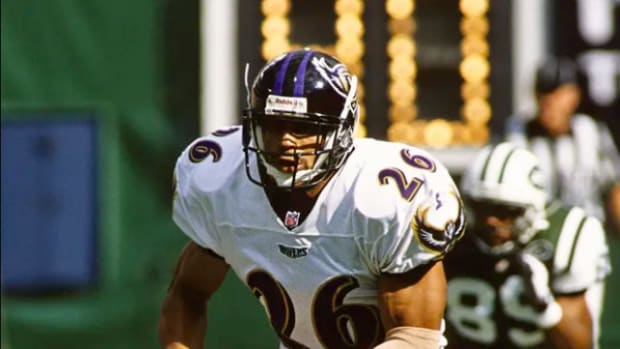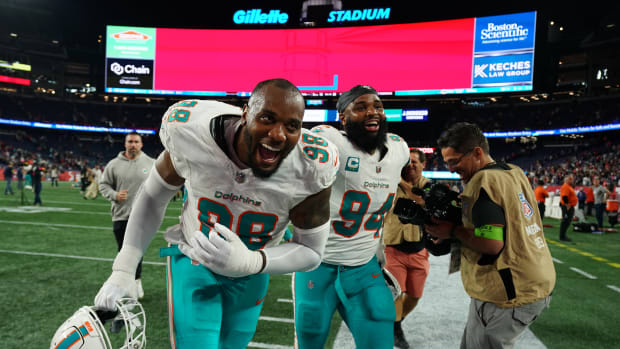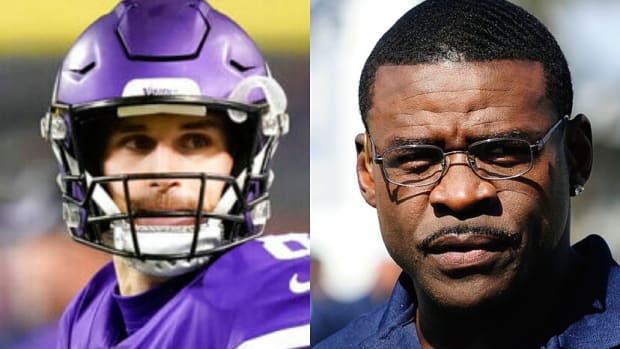10 Thoughts On the 2018 Minnesota Vikings, Who Have a New QB and the Same Dynamic Defense
With the NFL season just around the corner, Andy Benoit is previewing every NFL team in reverse order of last season’s finish. Up today: the Minnesota Vikings, who finished 13–3 in 2017.
1. Minnesota’s defense, which ranked first in both points and yards last season, should be even better in 2018. Its wide-scoping core of stars are all in their primes. Two of the most important of that bunch are Harrison Smith and Andrew Sendejo, the NFL’s best safety tandem. Smith is a five-tool player who doesn’t miss open-field tackles or turnover opportunities. He’s excellent as a strong side run defender and dangerous as a weak side pass defender.
Sendejo, undrafted in 2010, seems to play faster each week, and has developed into perhaps the NFL’s most underrated defender. He’s a testament to what happens when someone is well-coached and in the same scheme year after year. Though less gifted than the former first-rounder Smith, Sendejo is almost equally as dynamic, giving Minnesota invaluable interchangeability on the back end. This defense is fundamentally sound but not highly schemed. Head coach Mike Zimmer employs a lot of traditional zone concepts, particularly in two-deep safety structures. Smith’s and Sendejo’s flexibility gives these coverages just enough texture and disguise to make a QB hesitate.
2. The argument against Harrison Smith being this defense’s best player is that cornerback Xavier Rhodes is. Smith does his job better than anyone, but Rhodes, who shadows opposing No. 1 receivers, has the more significant job. Last season Rhodes won battles against receivers ranging from the quick and darting Antonio Brown to the long and limber Mike Evans. Rhodes can travel to the slot in select man-to-man situations, but most of his work comes on the perimeter, where his size, strength and knack for using the sideline come into play.
Will Green Bay’s Young CBs Take the Defense to the Next Level? 10 Thoughts on the 2018 Packers
3. It was a little surprising to see the Vikings use their first-round pick on cornerback Mike Hughes. We may not know what it means until 2020. Zimmer has a history of developing high-drafted corners from the bench, and the Vikings were already well-situated at this position, with 2015 first-rounder Trae Waynes maturing into a solid No. 2 and 2016 second-rounder Mackensie Alexander in the slot. Hughes has the skills to play inside or outside, and so his addition suggests one of two things: Either the Vikings don’t think Waynes—who had his fifth-year option picked up this offseason—is worth an expensive long-term deal, or coaches are skeptical that Alexander can blossom into the fulltime slot corner.
4. Zimmer was a pioneer in the double-A-gap pressure designs that are now a leaguewide norm, but his Vikings don’t blitz from this look nearly as much as his previous teams. In fact, 28 of Minnesota’s 37 sacks last season came off a four-man rush. Some of those four-man rush sacks still came from double-A-gap structures, with linebackers Anthony Barr and Eric Kendricks threatening to rush but retreating into coverage at the snap. Minnesota also did this often out of “diamond” looks, which have a balanced four-down front but with a fifth rusher standing over the center. These tactics will again be featured, creating one-on-one scenarios for long-armed end Danielle Hunter, bull-rushing extraordinaire Everson Griffen and newly acquired stud defensive tackle Sheldon Richardson.
5. Nose tackle Linval Joseph remains one of football’s premier run defenders. He’s a gap-clogger who can also penetrate. That’s crucial because Kendricks, more of a chaser than thumper, needs space around him in order to justify the $25 million that his new deal guarantees.
6. Kirk Cousins, like Case Keenum, is a system QB. But Cousins, being two inches taller and having a superior arm, presents a higher floor than Keenum. That’s why he’s here. The Vikings know their Super Bowl window will never be opened wider than it is now; they didn’t want to gamble on Keenum catching the same lightning in a bottle that he did in 2017. The return on the expensive Cousins investment will come down to how well the QB does when things break down. The lows in his topsy-turvy career have occurred when he’s had to deviate from the play design. Notably, those sandlot situations are where Keenum (shockingly) thrived most last year.
New Orleans’ Success Hinges on Its Defense: 10 Thoughts on the 2018 Saints
7. Cousins can consistently capitalize when the play design wins. And with wide receivers Adam Thielen and Stefon Diggs, your designs are likely to win. Thielen and Diggs are two of the game’s most bedazzling route runners. They possess not just speed and quickness, but the ability to harness it. They sacrifice almost no body control when accelerating or decelerating. That’s how you separate from defenders.
8. Look for Thielen and Diggs to often line up on the same side of the field. New offensive coordinator John DeFilippo loves trips formations. That includes formations where all three wide receivers are to one side and a tight end is alone on the other. DeFilippo—or “Flip,” as he’s known around the NFL—comes from an Eagles staff that did this often with tight end Zach Ertz. But in Minnesota, tight end Kyle Rudolph doesn’t quite have the athletic prowess to align on an island outside the red zone. It’ll be interesting to see how often DeFilippo tries it anyway, given the value of putting Thielen and Diggs side by side.
9. Thielen’s and Diggs’s ability to line up inside allows Laquon Treadwell to play fulltime outside, where his vertical style is better suited. It’s a make-or-break year for the 2016 first-rounder. He must become a more reliable route runner.
10. Minnesota last year ran the ball more than every team except Jacksonville. That commitment was notable given the ground game’s mediocrity. You can take the air out of the ball when you have a dominant defense. Expect just as much running this season, for two reasons: A) Cousins is at his best on play-action passing. While a stronger ground game is not required for having an effective play-action game, it certainly doesn’t hurt. B) Dalvin Cook is back from his early October ACL injury. That’s the big piece. Cook, with his nearly unmatched speed to the perimeter, has the ability to create his own yards. He’s not dependent on the decent—but only DECENT— run-blocking of Minnesota’s offensive line.
BOTTOM LINE: On paper, this Vikings team is better than last year's Viking team. But history has shown that doesn't guarantee more wins.
• Question or comment? Email us at talkback@themmqb.com.




































